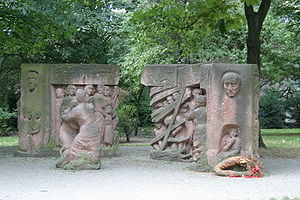Clearly, Celan's poem "Todesfuge"/"Deathfugue" had a powerful effect on Kiefer. Beginning in 1980 and going for more than twenty-five years, the artist names canvas after canvas either Margarete or Sulamit or a variation of those names, referencing the two women from the poem. (I'd like to add a note here that the naming of the Shulamite works, whether in English or in German lacks consistency in my source materials. I'll reflect those variations in the blog.) Kiefer uses many of the metaphors and devices connected to the uncanny in connection with the Holocaust that we have looked at earlier in this blog: the use of silence or a sense of void in the paintings, a sense of being unhomed, of a disruption to perception or to the senses, and the juxtaposing of unlikely images and materials to create a feeling of danger and peril in the work.
The early paintings tend to quote the poem fairly literally. Kiefer lays the final line of the poem, "Dein aschenes Haar Sulamit," directly onto the canvas. That line, which in English translates as "Your ashen hair Shulamith," speaks to the beloved of King David, who also functions in the Bible's "Song of Songs" as a stand in for the Jewish people. The ashen hair, a clear reference to the Holocaust with its ovens, appears representationally in these first paintings, both from 1981--Sulamit, a woman with her long hair.
"Dein Aschenes Haar Sulamit," (1981)
oil on canvas, 51 by 67 inches
oil on canvas, 51 by 67 inches
Kevin Hart contends that in these harsh strokes Kiefer is "showing how the reality of the Shoah manifests itself to him" (50), that is, that the work itself becomes a manifestation of the Shoah, an aesthetic belief we see shared by all the artists we are considering in this blog. Part of the strategy in these works comes from the shifting of context, that is putting one context within another, which disrupts the original sense, as it were, "unhomes" it, a defining basis for the uncanny. Each iteration embodies the same sense of atrocity in varying media. Hart goes on to express the sense that "[t]ime and again Kiefer tells us that we cannot ever be 'at home' in the world, and that the desire to be 'at home' in a land, a language, and a history, is itself courting of danger" (51).
your golden hair Margareta," "Hart quotes Kiefer about his process. "My thought is vertical, and one of its planes was fascism. But I see all its layers. In my painting I tell stories in order to show what lies behind history. I make a hole and I go through" (46). In that hole and that going through, both Kiefer and Celan move into the uncanny to explore ways the Holocaust disrupts and destroys homeland and "unhomes" all concerned, not just victims, but perpetrators.
The quality of the uncanny we see as silence, void, or absence, manifests in Kiefer in certain of the Sulamith, paintings. As I noted in an earlier blog, the painting below has what might be seen as a reduced reference to Sulamith, her name relegated to a corner. The sense of void here, of empty space, is palpable. We see references to the ovens in the death camps, to crypts, to ash. The reviewer, Kevin Hart explains that "what was dark has become darker now. In terms of tonality, the silence of Kiefer's canvases is not that of a world momentarily lifted out of time but of a time after the screams of the dying can no longer be heard...The silence of the works is the silence of mourning" (47-48)
Sulamit 1983For over twenty-five years, Kiefer has created these artworks based on the poetry of Paul Celan. Below is a sculpture that in 1990 takes Shulamith as subject once again. Media have shifted from canvas to soldered lead, female hair, and ashes. By this point these images have become layers of detritus, sediment. The form, moving ever closer to Celan, is a book.
Shulamith, 1990.
Book made from soldered lead, with female hair and ashes
64 pages, 101 x 63 x 11 cm.
64 pages, 101 x 63 x 11 cm.
The themes all remain in place. Kiefer continues to reference the Holocaustal uncanny in Celan with its sense of disruption, of "unhoming," of silence and the void, of the creation of the thing itself, not a representation of atrocity. Kevin Hart describes this process of layering as the gathering of the detritus of human suffering that offers "the very feel of the sediments of our past...[that] rise to a sharp point in horror itself" (51).








No comments:
Post a Comment